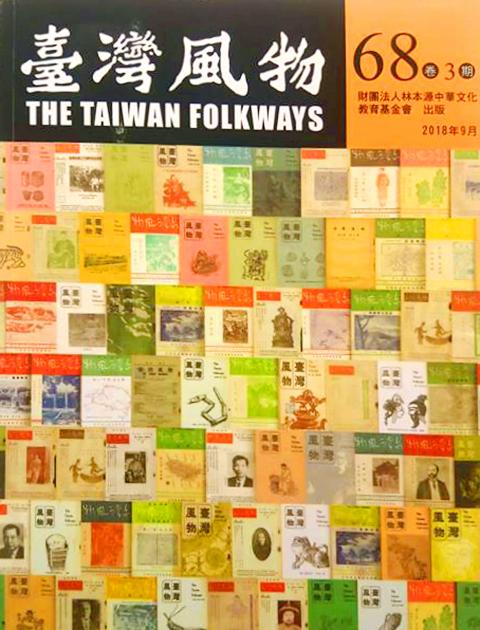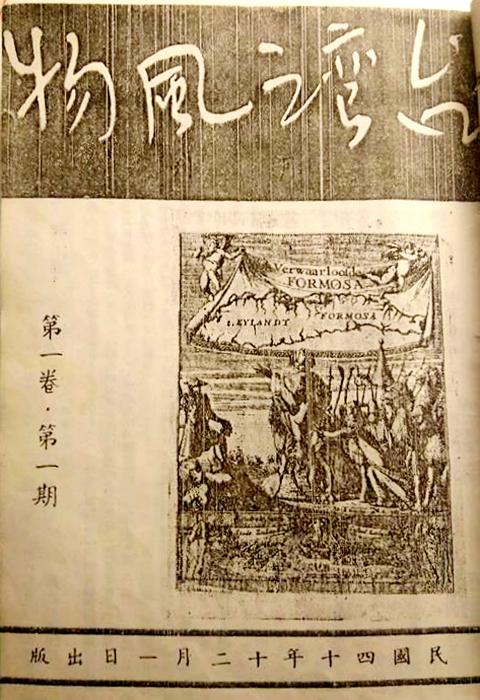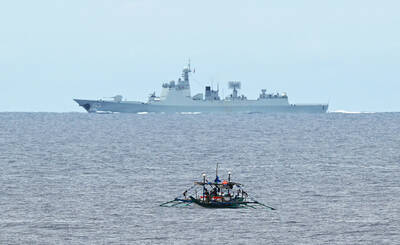Dec. 31 to Jan. 6
Devoted to a topic that the ruling government disapproved of, The Taiwan Folkways (台灣風物) struggled mightily in its early years. At one point, it was under such financial pressure that one issue simply contained handwritten manuscripts.
Former editor-in-chief and former Academia Historica president Chang Yen-hsien (張炎憲) writes that in the beginning of Chinese Nationalist Party (KMT) rule, Taiwanese intellectuals were eager to debate politics and discuss the uniqueness of Taiwanese culture. But such topics became taboo during the White Terror era. The government wanted people to identify with China and Chinese culture, and there was no official place for Taiwanese studies.

Photo courtesy of National Central Library
“Taiwanese culture was excluded from the education system … and scholars who were interested in the topic were unable to pursue it. Those who were interested in the field were left to fend for themselves by submitting amateur articles to independent publications,” Chang writes on the 60th anniversary of the founding of The Taiwan Folkways.
The publication debuted on Dec. 31, 1951, with 1956 to 1960 its toughest years. Stability finally arrived as Lin Chung-chih (林崇智) of the wealthy Banciao Lin Family became involved in 1966. It still survives today, making it the longest-running non-governmental publication in Taiwan.
JAPANESE PREDECESSOR

Photo courtesy of National Central Library
The Taiwan Folkways was heavily influenced by Minzoku Taiwan, a Japanese-language publication that, curiously, debuted in July 1941 when the colonial government’s Kominka Movement (皇民化運動), an effort to shift Taiwanese culture closer to that of Japan, was in full swing. The founder and publisher was Toshio Ikeda, who moved to Taiwan when he was seven years old, but he used various pen names due to his position with the Taiwan Governor-General Office’s information department. He partnered with Takeo Kanaseki, a prominent anthropologist, who used his reputation to serve “as a shield against government interference,” states the Catalogue of Taiwan Literature Journals Web site.
The publication ran for 43 editions until February 1945, covering topics ranging from daily customs to Hoklo (also known as Taiwanese) idioms to games, festivities, divination methods and medicine. It contained iconic illustrations and woodblock prints by Tetsuomi Tateishi, a Taiwan-born Japanese painter who contributed to numerous Taiwanese publications starting from 1935.
According to the Catalogue of Taiwan Literature Journals, The Taiwan Folkways closely mimicked Minzoku Taiwan’s editorial style, cover design, illustration style and the two were similar even in the number of pages. Many contributors to Minzoku Taiwan continued writing in The Taiwan Folkways, making it somewhat of a continuation of its colonial predecessor.

Photo courtesy of Wikimedia Commons
After World War II, the KMT established the Taiwan Provincial Editorial and Translation Bureau (台灣省編譯館) to continue the Japanese efforts on Taiwan studies — but the bureau lasted for less than a year, abolished shortly after the 228 Incident, an anti-government uprising and subsequent brutal crackdown. Much of its material was never published. After 228, the KMT established the Taiwan Historica (國史館臺灣文獻館) which focused on Taiwanese history. Historian Hsieh Hsueh-chi (謝雪姬) writes that the purpose was to pacify and assign a sense of purpose to the Taiwanese intellectuals who survived the incident. The bureau’s Taiwan Historica was the government’s only publication devoted to Taiwanese cultural studies.
The government’s efforts were obviously unsatisfactory, as The Taiwan Folkways criticized them in its second anniversary issue: “As early as 1944, the central government included ‘surveying Taiwan’s culture and customs’ in its plans for taking over Taiwan … Eight years have passed, and not only has the investigation of Taiwan’s folk culture not commenced, it’s not even taken seriously!”
ALL ABOUT TAIWAN

Photo courtesy of National Central Library
The Taiwan Folkways likely benefited from not being founded by a Taiwanese, but by Chen Han-kuang (陳漢光), a retired KMT military captain from China’s Fujian Province. Hsieh writes that whenever the government had a problem with the publication, Chen was able to use his status and connections to resolve the issue.
Chen’s editor-in-chief was Yang Yun-ping (楊雲萍), a literature scholar-turned-historian who was involved in both Minzoku Taiwan and the Taiwan Provincial Editorial and Translation Bureau. The Ministry of Culture’s Encyclopedia of Taiwan states that as a National Taiwan University professor, he was the first to teach a class solely devoted to Taiwanese history.
Chen’s first recorded publication was the 1948 History of Taiwanese Resistance Against the Japanese (台灣抗日史). In its preface, Yang wrote, “It’s hard to find a country in the world with a history as fascinating and complicated as Taiwan’s, but there are just too few publications and researchers. [Chen] can be seen as the post-war pioneer of the field of Taiwanese history.”
The inaugural issue of The Taiwan Folkways featured on the cover Neglected Formosa, a book by the last Dutch governor, Frederick Coyett, about how the Dutch colonizers were expelled from Taiwan by Ming Dynasty loyalist Koxinga (鄭成功). In the call for submissions, it stated: “This publication is devoted to writings about Taiwan’s history, geography, arts, folk culture, religion and so on. We also welcome articles about [China] that directly or indirectly relate to Taiwan.”
The articles in the first issue include “Discussing the parameters of Taiwan’s prehistory,” “Earthquakes during the Dutch colonial era,” “Legends from Shilin,” “Taiwan folktales,” an etymology of the words for “man” and “woman” in Hoklo and an introduction to the music played at Tainan’s Confucius Temple.
The editors had to tread carefully to keep anything that would potentially offend the government from making it into the publication. Nevertheless, it was suspended once for two months, and Hsieh writes that it was forced to include a poetry supplement celebrating then-president Chiang Kai-shek’s (蔣介石) 66th birthday. She postulates that this led to Yang’s departure after that issue was published on Dec. 1, 1952.
Chen soldiered on, somehow keeping the publication afloat for 14 more years until Lin came aboard.
Taiwan in Time, a column about Taiwan’s history that is published every Sunday, spotlights important or interesting events around the nation that have anniversaries this week.

Late last month Philippines Foreign Affairs Secretary Theresa Lazaro told the Philippine Senate that the nation has sufficient funds to evacuate the nearly 170,000 Filipino residents in Taiwan, 84 percent of whom are migrant workers, in the event of war. Agencies have been exploring evacuation scenarios since early this year, she said. She also observed that since the Philippines has only limited ships, the government is consulting security agencies for alternatives. Filipinos are a distant third in overall migrant worker population. Indonesia has over 248,000 workers, followed by roughly 240,000 Vietnamese. It should be noted that there are another 170,000

Hannah Liao (廖宸萱) recalls the harassment she experienced on dating apps, an experience that left her frightened and disgusted. “I’ve tried some voice-based dating apps,” the 30-year-old says. “Right away, some guys would say things like, ‘Wanna talk dirty?’ or ‘Wanna suck my d**k?’” she says. Liao’s story is not unique. Ministry of Health and Welfare statistics show a more than 50 percent rise in sexual assault cases related to online encounters over the past five years. In 2023 alone, women comprised 7,698 of the 9,413 reported victims. Faced with a dating landscape that can feel more predatory than promising, many in

“This is one of those rare bits of TikTok fitness advice with a lot of truth behind it,” says Bethan Crouse, performance nutritionist at Loughborough University. “Sometimes it’s taken a bit too literally, though! You see people chugging protein drinks as they’re scanning out of their gym.” Crouse recommends the athletes she works with consume 20-30g of protein within 30-60 minutes of finishing a resistance training session. “The act of exercising our muscles increases the breakdown of muscle proteins,” she says. “In order to restore, or hopefully improve them — and get gains such as increased muscle mass or strength —

“Far from being a rock or island … it turns out that the best metaphor to describe the human body is ‘sponge.’ We’re permeable,” write Rick Smith and Bruce Lourie in their book Slow Death By Rubber Duck: The Secret Danger of Everyday Things. While the permeability of our cells is key to being alive, it also means we absorb more potentially harmful substances than we realize. Studies have found a number of chemical residues in human breast milk, urine and water systems. Many of them are endocrine disruptors, which can interfere with the body’s natural hormones. “They can mimic, block